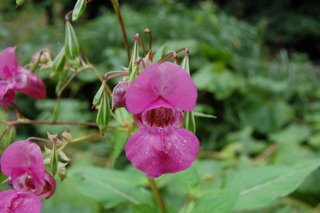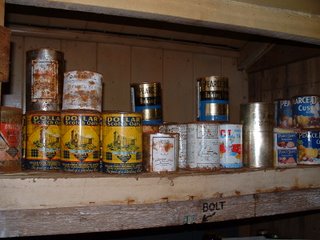
Tuesday, August 29, 2006
Sunday, August 27, 2006
Jazz at the Old Duke




For many years the world famous jazz pub The Old Duke in Bristol's historic King Street holds an August Bank Holiday Jazz Festival. Jazz bands play to appreciative audiences in the open air between the Duke and the older pub, the Llandoger Trow which is only too pleased to sell more beer to the jazz goers.
I spent a very enjoyable time yesterday afternoon, chatting, having a beer, listening to the bands and taking a few photos. It is a wonderful event for people watching; families, students and jazz lovers of all shapes and sizes pack the end of King Street, sitting on the cobbles or on the benches outside the two pubs. It's a date again for next year! ;-)
Tuesday, August 22, 2006
D0n't t0uch me!

 Since 1839 the British Isles have been colonised by an attractive but highly invasive plant species. Victorian travellers to India brought the plant back to add to their gardens, but now it is to be found on most of our riverbanks. Walking beside rivers as I often do during the summer, it is not long before the tall stems of Himalayan Balsam are evident. It is a garden escape that has been particularly successful in its spread throughout the country. It is a tall, robust, annual producing clusters of purplish pink (or rarely white) helmet-shaped flowers. Also called Jumping Jack, Policeman’s Helmet, Indian Balsam and the “bee bum plant”. This last because when a bee enters the helmet shaped flower that is all one can see of the bee. It has the impressive Latin name of Impatiens glandulifera and is also the Noli-me-tangere plant – from the Latin for “Don’t touch me” because touching the seed pods at this time of year sends the seeds flying in all directions. Each plant can produce up to 800 seeds and can shoot them from the pods up to 7 metres away, which is why it is so successful in its dispersal.
Since 1839 the British Isles have been colonised by an attractive but highly invasive plant species. Victorian travellers to India brought the plant back to add to their gardens, but now it is to be found on most of our riverbanks. Walking beside rivers as I often do during the summer, it is not long before the tall stems of Himalayan Balsam are evident. It is a garden escape that has been particularly successful in its spread throughout the country. It is a tall, robust, annual producing clusters of purplish pink (or rarely white) helmet-shaped flowers. Also called Jumping Jack, Policeman’s Helmet, Indian Balsam and the “bee bum plant”. This last because when a bee enters the helmet shaped flower that is all one can see of the bee. It has the impressive Latin name of Impatiens glandulifera and is also the Noli-me-tangere plant – from the Latin for “Don’t touch me” because touching the seed pods at this time of year sends the seeds flying in all directions. Each plant can produce up to 800 seeds and can shoot them from the pods up to 7 metres away, which is why it is so successful in its dispersal.Since its introduction it has become naturalised, especially on riverbanks and increasingly in waste places and has become a problematical weed. Himalayan balsam tolerates low light levels and, in turn, tends to shade out other vegetation, impoverishing habitats. It is sometimes seen in gardens, either uninvited or grown deliberately, but care must be taken to ensure that it does not escape into the wild.
The eradication of the plant is widely encouraged, and usually the most appropriate method is by pulling up or cutting out plants before they flower and set seed. Conservation authorities regularly organise ‘balsam bashing’ work parties to clear the weed from marshland and riverbanks but their work has only managed to clear small areas. As the seeds remain viable for up to two years re-colonisation is commonplace.
As I said, it is an attractive plant and if it did not shade out our native flora I would otherwise be more pleased to see it.
Saturday, August 19, 2006
Farmland Birds in Decline

This scruffy little chaffinch is to illustrate an article I have just been reading. Quite apart from climate change, in the UK there have been many changes to the agricultural scene over the last two or three decades and some of these have affected wildlife. Some species have declined but some have increased over the period and are continuing to do so. Among the losers have been skylarks, corn buntings, tree sparrows, bullfinches and turtle doves, while song thrushes and some of the rarer birds have been increasing.
I have been lucky this spring and summer to have seen or at least heard, many species of birds. The chaffinch was singing in a tree above the lane in Marshfield, near Bath at the end of June where I was able to try out my new camera and zoom lens for the first time. In farmland I have also seen skylarks, thrushes corn buntings and yellowhammers in good numbers as well as many other species like grey partridge, little egrets, herons, quail (heard). I could go on, and while none of my species seen is particularly rare or even endangered it is worrying to note that there are still marked declines in formerly common species.
Tuesday, August 15, 2006
Thursday, August 10, 2006
Conservation in the Far South


I was privileged to have visited last December the British Antarctic Survey historical base at Port Lockroy on the Antarctic peninsula. I now read with great interest of the conservation work being done on the Scott and Shackleton huts on the edge of the Ross Sea, much further to the south than my tourist cruise had ventured.
"There is a corner of Antarctica that is forever Britain. On the shores of Ross Island there are three wooden huts left behind by Robert Scott and Earnest [sic]Shackleton's expeditions a century ago - a snapshot frozen in time. It is something of a miracle that the huts have survived, but now ice, winds, salt and warmer summers are sounding their death knell. Ironically, New Zealand is leading the fight to save them."
The above comes from an article in this week's New Scientist and is well worth reading. Sorry that link works fully only if you subscribe to New Scientist. This link is good!
My photos show the Port Lockroy Base and Museum which has food items dating from the 1950's. On the rocks out side the building are nesting Gentoo Penguins.
Wednesday, August 09, 2006
My Photo of the Day
Tuesday, August 08, 2006
Monday Night was Music Night
I had planned to go to Bristol's Nova Scotia Hotel Folk Club for ages and was dismayed to find on arrival that the the little upstairs room was full to the brim and at first I was turned away. Later, a few more people were squeezed in and I was lucky to be able to stand by a wall and near to an electric fan. The guest artist last night was Michael Chapman who entertained us until after 11 o'clock with some of his songs and fantastic guitar playing. Toward the end of the final set he was joined by Keith Warmington [one of our larger than life BBC Radio Bristol presenters] on harmonica.
Standing there, among many other appreciative people on a hot evening , I was reminded of a time, different location, different genre, when I visited the Preservation Hall in New Orleans where generations of traditional jazz musicians have played to audiences just as appreciative. Michael Chapman has been performing since the 60's and his gravelly voice and generally grizzled appearance compared in my memory with the old guys I saw in New Orleans back in 1972. I hope he continues for many more years and I am pleased to see that the Preservation Hall has survived the floods and is thriving again and still costs very little [$8] entry.
Standing there, among many other appreciative people on a hot evening , I was reminded of a time, different location, different genre, when I visited the Preservation Hall in New Orleans where generations of traditional jazz musicians have played to audiences just as appreciative. Michael Chapman has been performing since the 60's and his gravelly voice and generally grizzled appearance compared in my memory with the old guys I saw in New Orleans back in 1972. I hope he continues for many more years and I am pleased to see that the Preservation Hall has survived the floods and is thriving again and still costs very little [$8] entry.
Saturday, August 05, 2006
Not enough being done!
I was chatting on line with a man in China yesterday morning and he told me that he could not access the BBC website. We assumed that this is because it is blocked by the Chinese government which is sad. I rely on the BBC for much of my knowledge base and as I have used BBC links in several of my posts, I do hope that my visitors here can read them. Just this quick post with a link today to a piece about the interview with the President of the Royal Society, Lord Rees, who gives a plea for much more to be done by the governments to increase research in alternative technologies.
You can [unless barred!] also listen to the interview on line.
I was dismayed by the final sentence of the article: - The International Energy Agency predicts that by 2030 global energy demand will increase by 50%. If that is the legacy my generation is passing on, there is going to be a very different and troublesome world then for our children and grandchildren.
You can [unless barred!] also listen to the interview on line.
I was dismayed by the final sentence of the article: - The International Energy Agency predicts that by 2030 global energy demand will increase by 50%. If that is the legacy my generation is passing on, there is going to be a very different and troublesome world then for our children and grandchildren.
Thursday, August 03, 2006
The Trilobite Dingle

I had a very busy weekend in Mid-Wales, returning to Bristol last Sunday evening. I had managed to visit several friends and relatives and also spent some time on my own re-visiting old haunts. I have been visiting Montgomeryshire, the family home of my late grandfather regularly for as long as I can remember and have special affection for the rivers and "hump-backed little hills... lying like sleeping lizards in the sunlight." [Pauline Phillips]
On Sunday morning waiting between breakfast and a suitable time to visit my aunt, I visited a famous geological locality, the Trilobite Dingle in Bronybuckley Woods just outside the town of Welshpool. Here, scrambling down to the bed of a little stream one can still find ancient Ordovician shales containing Trilobites over 450 million years old. The rock disintegrates easily and broken shale lies around the stram bed making it relatively easy to spot the Trilobites. Whole specimens [as with most fossils] are rare but I collected a few specimens of heads and head shields and have taken photographs of them as you see above. I am fascinated by this early life, something that has no living relatives, that was common in the early oceans, leaving us too few clues as to their ways of life. The species here is Salterolithus caractaci.
Subscribe to:
Posts (Atom)



